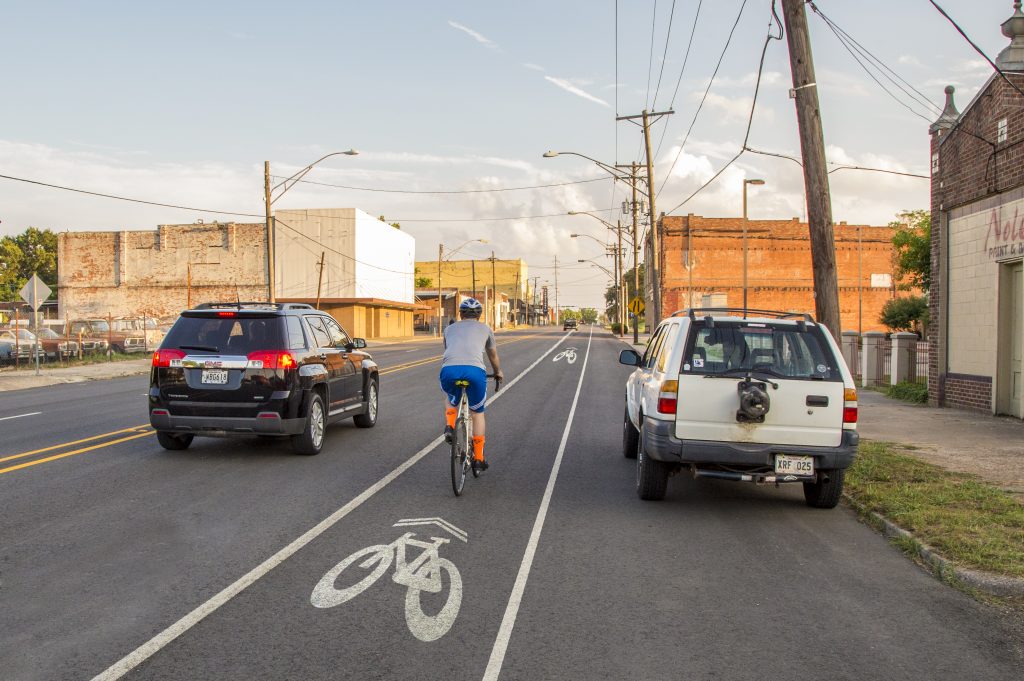Chris Lyon contributed to this article.
Groundhog Day was a few weeks ago, but I still feel like I’m reliving the same scenario over and over again. Since moving to Shreveport in 2010, I’ve participated in charrettes, forums, community dialogues, vision planning, and shareholder meetings all concerned about bike lanes and paths. After every dead end meeting I swear that it will be my last one, only to get roped back in thinking that this time we’ll make it into the implementation phase.

For me, the final attempt took place in the form of NLCOG (Northwest Louisiana Council of Governments) hiring consultant Bud Melton to create the 2016 Caddo Parish Bicycle Plan. Bicycle and pedestrian advocates fully supported the effort and gave their input from the very beginning, to the final publication. By being engaged and having their input feel valued, advocates had hope that this plan would lead to action.
The plan took the input from cyclists to create an overlay of “Desire Lines,” which consisted of almost every major street in the Highland and South Highland neighborhood. Was this realistic? Of course not. The paths are subjective and reflect the routes being taken by individual cyclists to go from their home to work, and to points of interest. From there, Melton incorporated these feasible routes into “Priority Recommendations” which represented the best approach for implementing bike/ped infrastructure.

For the Highland and South Highland neighborhoods, it highlighted Fairfield and Creswell going north-south, and Ockley, Kings Highway, and Stoner Avenue going east-west (Note: Of course Kings isn’t going to have a bike lane anytime soon, this is merely to say that it would be a great candidate if the entire street was planned to be widened). Any cyclist in this city can tell you that Fairfield and Creswell are the two most used streets to connect to downtown Shreveport.
On February 2nd the City of Shreveport circulated a plan that aimed to implement bicycle lanes on Gilbert going two directions, Fairfield going only north-bound, and Centenary only going south-bound. For east-west they plan a bike lane on Ockley going west-bound, with the idea that these streets would create a circle, linking bike lanes into downtown.
I and Stephen Pederson, the creator of the advocacy and awareness group Bike Shreveport, posted comments in a recent Heliopolis article questioning certain aspects of this plan. The main questions were: Why have a bike lane on only one side of the street? Why not restripe using sharrows (symbols that remind drivers that bikes can share the road) on some bicycle-preferred streets, which is far cheaper than creating an entire bike lane? Why did the City choose Gilbert and Centenary, streets that were not a part of the NLCOG Priority Recommendations?
On February 6th, the City of Shreveport arranged a public discussion of their plan, helmed by Mayor Tyler, Chief Administrative Officer Brian Crawford, and City Engineer Robert Westerman. Mayor Tyler and Brian Crawford opened up the meeting by detailing how much work the City has done with the street repaving, how frugal and well implemented their plan is, and how they wanted to assure everyone that they are open and receptive to anything we had to say. Robert Westerman took the podium and went through the plan as it was presented. An interesting thing to note is that Westerman displayed the “Desire Lines” map from the NLCOG plan, not the “Priority Recommendations” as the justification for the addition of Gilbert and Centenary. Mayor Tyler and Brian Crawford then responded to audience questions.

The atmosphere of the room was certainly that the City was defensive. I had received word in response to my comments on the Heliopolis article that I was supposed to “be nice” and “not be so hard on them.” The only questions I had were why they chose the streets that they did, and what their reasoning was behind having a bike lane going one direction.
The response to these questions ranged from indifference, to apologetic, to a memorable response of Westerman saying “Well I guess we won’t be doing Centenary!” in an exasperated tone due to the constant questioning about his routes. The takeaway is that the routes, as they were chosen, and the reason for the single bike lane infrastructure has to do with on-street parking and cost, not cycling preference or priority. The team simply drove the streets, noted on street parking, and stuck a bike lane on one side of the road if they could do it. No best practices, no cyclist feedback, no references to the NLCOG plan. They did not want to keep the four narrow lanes on Gilbert so they wanted to put in bike lanes, despite the fact that any cyclist in town will tell you that Gilbert is not a preferred route (compared to Highland and Creswell) and that backlash from motorists is sure to mount. Rather than be receptive to the discussion, the City was on the defensive making cyclists seem ungrateful when all the City had to do was look at the NLCOG study for recommendations.

After the meeting I visited with Councilman Jeff Everson, Brian Crawford, and Robert Westerman. Councilman Everson was receptive to my feedback about the seeming waste of information from the NLCOG study that could have made this meeting more productive. Mr. Crawford was defensive from the start of our chat, defending himself as a fellow cyclist, then speaking over me when I indicated that it may be more effective to remove the plans for single bike lanes, replacing them with sharrows. He claimed that the City did not have any money to put sharrows on Creswell or Highland, when I was actually trying to explain that if the City would do less and just focus on the Priority Recommendations of the NLCOG plan, we can be successful both as cyclists and as City officials. Finally, Mr. Westerman took a deep breath as I approached with the NLCOG map in hand. “You know the guy they hired to make that plan was just a consultant, right?” he responded. As I tried to switch the conversation, asking him out of curiosity what the legal lane widths of both automobile lanes and bike lanes are, he struck a condescending tone and ended up the conversation.
Blinded by the frustration and disappointed that the effort put into the NLCOG plan by the cycling community was futile and wasted, I’ve waited until now to put my thoughts on this page. While the City will get the brunt of the opposition from angry motorists, especially from the reduction of Gilbert, it’s the cyclists who will ultimately pay by facing aggressive drivers and antagonistic fronts. Cyclists want the first implementation of cycling infrastructure to be a success, and the City has created the perfect time to do so with the repaving and restriping of roads. However, this will only be a success if the City actually listens to cyclists, asks for their input before publishing their plans, and refers to the wealth of information that NLCOG and Bud Melton collected in their study.

For me, this was a disheartening experience learning yet another Bicycle/Pedestrian study is doomed to sit on the bookshelf, and that our City administrators and politicians are so reticent to take constructive feedback. I never intended to be a critical voice in a time when cycling infrastructure is so close to being a reality, but this needs to be handled correctly.
Over the last week, I have worked with other bike enthusiasts (including Stephen Pederson of Bike Shreveport, Chris Lyon, and others in the biking community) to create a set of clear recommendations for the city regarding the Bike Lane pilot program. It is our collective view that creating a program that is designed for success using nationally-recognized best practices, input from cyclists, and considerations for those who live along the bike lanes is the most prudent path forward.
The Great Compromise
Suggested changes to City of Shreveport Administrative Action Plan 2015-2017 Roadway, Appendix D: Bike Paths for Streets on Collector Roadway Asphalt Program.
- Recommended removal of Centenary Blvd. from this pilot program. If Centenary is to be included, preference is bi-directional sharrows instead of bike lanes.
- Prioritize bi-directional bike lanes where possible. Preference: Fairfield Ave. and Gilbert Dr. south of Kings Hwy.
- Utilize sharrows where bi-directional bike lanes are not possible OR on-street parking is prohibitive instead of creating uni-directional bike lanes. Preference: Creswell Ave., Ockley Dr., Gilbert Dr. north of Kings Hwy.
- Reduce car lanes from 12’ to 10’ as a nationally-recognized best practice to reduce speeding and accident occurrence while creating additional space for bike lanes.
See the map below which illustrates recommended changes to accommodating shared lanes, on-street parking, and appropriate bi-directional bike lanes which promote a successful biking pilot program.
To share your thoughts with the city about bike lanes, email bikelanes@shreveportla.gov.


